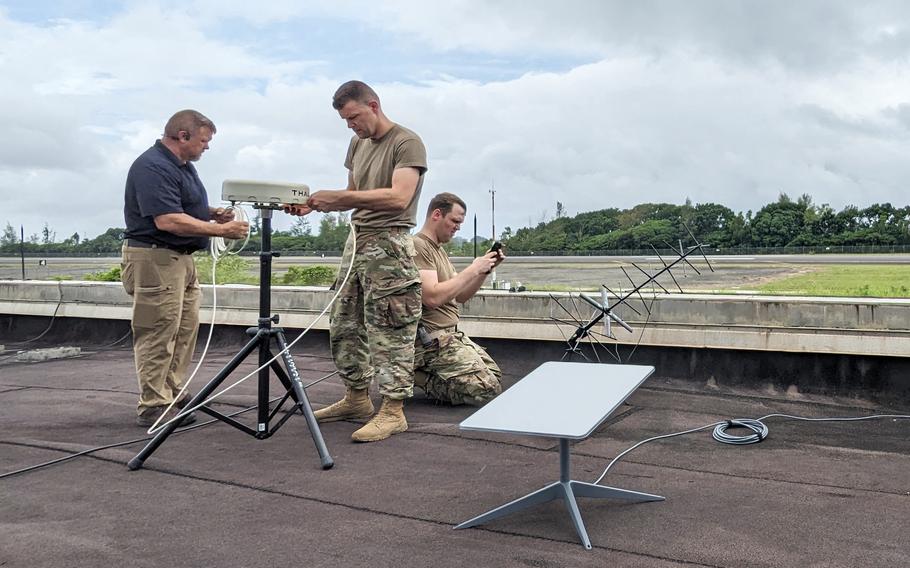
Air Force personnel and a contractor set up communications equipment on a Palau rooftop during the Rally in the Pacific exercise, Sept. 12, 2023. (Jessica Kendziorek/U.S. Air Force)
Pacific Air Forces has stood up a directorate consolidating the combatant command’s approach to cyber operations and communications with the aim of modernizing infrastructure in an era of economic and military competition with China.
The Cyber Operations and Warfighting Communications Directorate came online Jan. 31.
The directorate’s first order of business is upgrading and improving neglected and outdated cyber and communications infrastructure at Pacific Air Forces installations, Col. Eric Crowell, head of the new directorate, said by phone Friday.
“The intent of modernizing is to make sure that we remain competitive and that we can achieve the enhanced warfighting communications necessary as we address great power competition and how we are going to posture ourselves in that environment,” he said.
In need of replacement with the newest fiberoptics available are old-style copper wiring and early-generation fiber cable.
Data centers, servers and routers also require upgrading, he said.
“The storage wasn’t being maintained or upgraded fast enough to keep up with modern technologies that we’re building out,” he said.
Plans to speed up “sensor-to-shooter capabilities” have been at times stymied by networks unable to handle such technological upgrades, Crowell said.
“My first task is to build that infrastructure back up so it can handle those tools and the processes that are required for those tools to work across the network,” he said.
The new directorate is part of the sweeping plan unveiled by the Air Force in early 2024 for “reshaping, refocusing, and reoptimizing the Air Force and Space Force” to maintain supremacy in the era of “great power competition” with China, the service states in online fact sheets.
Crowell said that Pacific network needs to be robust enough to support the tactical communications that are central to the Air Force’s agile combat employment concept.
That model employs a hub-and-spoke system of established and remote air bases and prepositioned equipment that allows quick and unpredictable deployment of air assets.
That requires “upgraded equipment that we could rapidly move into bare-based locations” and “a network I can reach back into” at established installations, Crowell said.
The new directorate separates the communications and data network functions from air operations.
As such, the heads of the new cyber directorate and air operations will each directly advise Gen. Kevin Schneider, commander of Pacific Air Forces.
Roughly 15 years ago, the Air Force integrated those functions to enhance the burgeoning field of cyber defense and offense operations.
The Air Force last year began dividing those two functions, with the aim of elevating the importance of each in any future conflicts.
Previously, pilots in air operations spoke for both air and cyber operations in advising the combatant commander.
“So, most of the conversations would drive towards the daily fire of air operations and exercises and other events that were happening.
“There’s only so much time at the table, so often the communication pieces would get tabled and get caught in an email at a later date or something like that,” Crowell said.
The new directorate “allows me to directly address our issues and bring it up to General Schneider in a timely fashion,” he said.